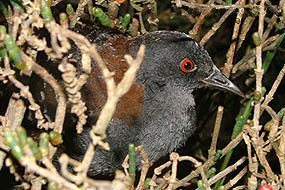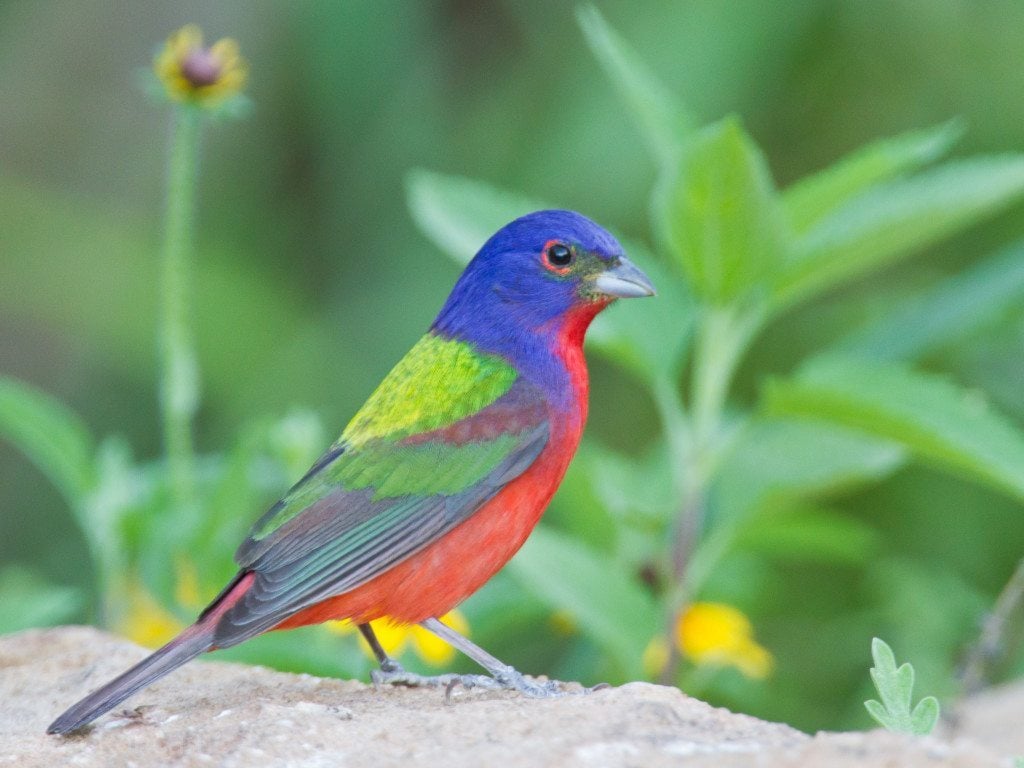Lani’s Big Year goes to Florida
Note: This is the fourth in an ongoing series of posts by GGBA member George Peyton about his better half Lani Rumbaoa’s effort to spot 600 bird species within the Lower 48 states during 2015.
By George Peyton
Four days of birding in South Florida added 46 new species to Lani’s Big Year List, including some difficult-to-see Target Birds.
Because we only had a short time to bird in South Florida and some of our Target Species can be difficult to locate, we decided to engage the services of a local professional bird guide, Larry Manfredi, whose sharp birding skills would be invaluable in helping us quickly locate species such as Purple Swamphen, Red-whiskered Bulbul, White-crowned Pigeon, and Spot-breasted Oriole. These and other special species can be found in suburban neighborhoods around the Greater Miami Area but periodically shift their locations, so having someone like Larry, who is constantly checking local sightings, can make a huge difference between success and failure in seeing the bird.

The first thing that I always do as Lani’s Big Year Manager when visiting a new area is to make a List of Target Birds that are likely to be there and possibly difficult to see elsewhere. This applies whether it is Greater Susanville, CA or Greater Miami, FLA. Lani reviews each target species and its field marks in the latest (Sixth) edition of the National Geographic Guide, which we also carry with us in the field, backed up by the second edition of the much larger and heavier Sibley Guide, which stays in our car for further reference purposes.
I also email the Target Bird List to local birders or professional bird guides well before we visit the area for help planning our route. That applies even when Lani and I are birding entirely on our own, as we did in most of South Texas in February. ABA (American Birding Association) Bird-finding Guides and other state or local bird-finding guides can also be extremely helpful in this planning process.
An example of a carefully planned birding day in South Florida:
Larry Manfredi picked Lani and me up at 6:30 a.m. in Homestead, Florida, about an hour before sunrise. We drove directly out to an area of low grass and marsh vegetation in Everglades National Park, where, just as it was getting light, we listened for the distinctive calls of King and Black Rails. We lucked out with a Black Rail calling close to the road, but the King Rail was a no-show.

We then turned our attention to locating Seaside Sparrow in the very same area. Seaside Sparrows are not easy to see, at least in the Everglades, since they often sing their breeding songs from within low clumps of grass rather out on the top. After about 20 minutes of effort, Larry finally spotted a singing Seaside Sparrow and promptly had it in his scope — and we had good views. Then back to the car and off to Mahogany Hammock, where Larry took us to see a Barred Owl in its nest.
We drove rapidly to an area just outside of Everglades National Park, where Larry promptly located a wintering Scissor-tailed Flycatcher before it moved away from the road as it often does by later in the morning. Larry then reversed direction back into the park to an area of Caribbean Slash Pines, where he quickly found Lani both Brown-headed Nuthatch and Pine Warbler. All of this was accomplished by a little past 9 a.m.

Next we drove about 15 minutes to Larry’s home looking for Shiny Cowbird, a very difficult-to-see species that shows up at his backyard seed feeders (Lani had picked up four new Yearbirds in Larry’s backyard late the previous day!) We had the good luck to see three species of Cowbirds — Brown-headed, Glossy and Shiny — all feeding next to each other on the same feeder, an excellent opportunity to compare field marks.
A two-hour-plus drive north up the Florida Turnpike and a rapid lunch at Subway brought us to Jonathan Dickinson State Park, near Jupiter Island. After walking several hundred yards up a trail, we had great looks at three separate Florida Scrub-Jays, another species only found in that state. Back to the car and after no luck at several locations within the park, Larry located another Target Species, Bachman’s Sparrow, which sang its little heart out for us for some time.

We headed back south to Boca Raton and off to a city park, where Larry had located Nanday Parakeets. With some effort we found three Nandays. While we were checking a hole where Nandays had nested in 2014, what should pop out but an Eastern Screech-Owl, a really cute bird that stayed partly out of the hole the entire time we were there.
The next birding location was a number of miles west of Miami, where we hoped to locate a Red-cockaded Woodpecker. But since it was after 3:30 p.m. and we faced a possible three-hour-plus drive back through rush hour traffic, we made the strategic decision to save the Red-cockaded Woodpecker for our upcoming visit to Texas.
We arrived back at our base in Homestead a little before 7 p.m., a long but successful day of birding. I would recommend Larry Manfredi as your birding guide if you want to locate many species in South Florida. (By the way, the previous day Larry took us to the nest location of one of my favorite birds, Swallow-tailed Kite, where we had great views of the two parents, both flying and on the nest. We would never have seen that nest on our own.)
Now a bit about the very special place that was our home-away-from-home in South Florida. Palm Lodge is a wonderful historic home built by a real Kentucky Colonel back in 1912 as the center of his tropical fruit business covering many acres. The unique home and some surrounding acres were purchased many years ago by my close birding friend John Ogden and his wife Maryanne Biggar, and kept as a sanctuary with many tall palms, orchids and other plants.


I met John Ogden when we both were around 12 or 13 years old, and he was the red hot young birder in Nashville, Tennessee, while I was the same in Memphis. John went on to become Chief Ornithologist at the National Audubon Society, during which time he was key in starting and managing the Condor Recovery Program in California. He went on to become the co-leader for many years of the $32 billion Everglades Restoration Program before his untimely death three years ago.
Maryanne, John’s wife, had welcomed us when we arrived in Homestead by showing us Painted Buntings on the seed feeder right in front of the house, which we saw much of the time we were there, since they overwinter in the yard at Palm Lodge. The male Painted Buntings are absolutely gorgeous and one of my very favorite bird species, which I first laid eyes on when I was only 10 years old.

While she would never admit it, besides being an excellent cook and a very talented botanist, Maryanne is also a great birder, and she led us on a full and very successful day birding in the Everglades, where Lani added Short-tailed Hawk to her Big Year List.
All in all, Florida gave a real boost to Lani’s Big Year, which was up to 374 species by the time we returned to California.
Next stops – the Colorado Chicken Tour to be followed immediately by two weeks of intensive birding along the Coast and in the Hill Country of Texas at the peak of spring migration there, a total 3½ weeks of constant long days of birding. Wish Lani well!
—————————————
You can read George’s previous posts about Lani’s Big Year at goldengatebirdalliance.org/tags/big-year/
